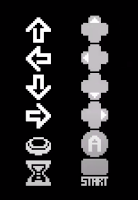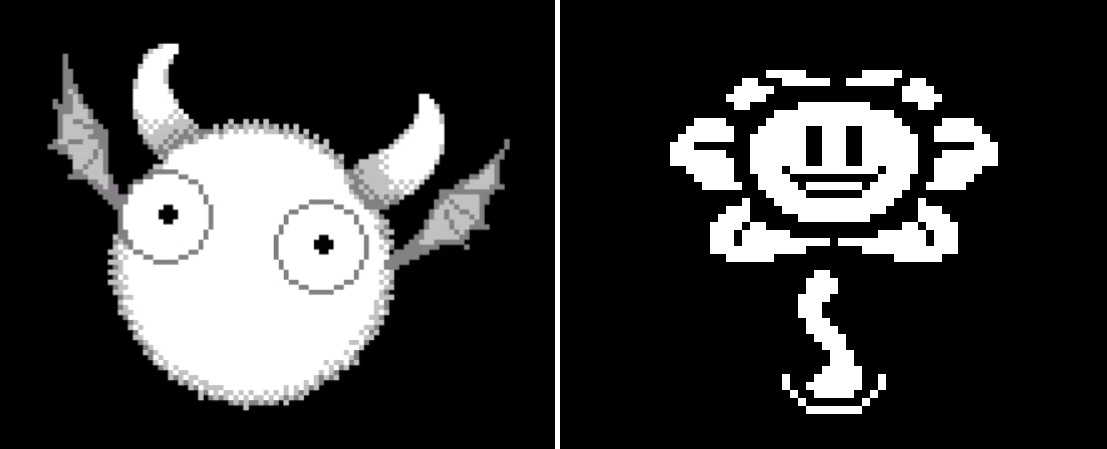Void Stranger and Player Expectations
After hearing murmurings from Super Eyepatch Wolf and others, I decided to jump into system_erasure's latest game Void Stranger completely blind...
This is normally where spoiler warnings would be appropriate, but I'm not sure how much I could possibly spoil given I haven't really started the game yet. That's right; I'm stopping to write this in response to playing the game for all of 5 minutes!
Before even getting past the title screen, I am confronted with a dynamic representation of the simple controls; Up, Left, Down, Right, A, and Start, in black, white, and gray against a field of rising particles. The interface responds to inputs and makes it clear that my controller is indeed working, but pressing Start simply causes it to light up; it does not allow me to actually start the game...
How strange.
A bit of thrashing around on the buttons yields a minor discovery; did the particles rising in the background just move because of something I did? Ah, yes! The other directions don't appear to be doing much, but if I hold Right then the particles accelerate to the left, giving an illusion of movement or momentum. Holding Right for a few more seconds makes it obvious that the menu is going to hold me prisoner regardless of horizontal movement, but this interaction has communicated an important idea;
Holding an input might differ from pressing an input...
Sure enough, holding the A button fills up a bar and starts the game!
A bit of further calibration follows; language selection, (apparently system_erasure is Finnish, that's interesting) display settings, all standard menu interfaces that lack the curious friction of that initial controls screen, but I notice that the grayscale presentation can be switched to a variety of different retro palettes before settling into the defaults. I would never have guessed that this color selection could matter given I'm still trying to take in what an interesting design choice it is to make a game's very first impression that of a controls hiccup.
A start button that won't start the game gives the player pause...
That little bit of abrasion exists to increase player mindfulness, and it's an effect that accidentally used to be much more prominent in the days before the game industry had developed rigorous and largely unspoken sets of rules and guidelines; best practices for everything from coyote time when walking into bottomless pits to the way a menu should behave. Some NES games demanded that the player mash one of the squishy lozenges calling itself a select button to advance the cursor on the main menu, even though the directional buttons were sitting right there, mapped to nothing. Renting a game from your local video store might not supply you with an instruction manual, and without access to the internet, players were often required to use deductive reasoning to accomplish simple tasks like saving, loading, or working out how to play in the first place. From a media consumption standpoint, some of this "formative" design variance between titles led to player experiences that were not great. But from the perspective of your limbic system, it also shifted your brain from "passively curious" mode to "actively learning" mode.
If you've ever wondered why a lot of the stickiest and most profitable mobile games manage to rope people into diving through reams of seemingly poorly planned Game of War: Fire Age style menus in order to claim dozens of different free rewards, consider how little attention a "well designed" single Claim Everything button commands by comparison.
As a designer, you can accomplish certain things with well apportioned little doses of frustration or difficulty that would be nearly impossible with best-in-class frictionless ease of use; the correct amount of poisonous friction might just be a cure for the illness that is flagging player engagement.
+ + +
Are you ready? the Void Stranger menu asks.
I certainly hope so; if that first screen was a call to pay attention, then the next one clearly communicates that this may not be your typical pixel art indie game.Instead of requesting that I enter my name, Void Stranger entreats;
Engrave your brand.
And I proceed to carve a binary pattern into the proffered six-by-six grid using an ornate cursor.
This is a simply striking bit of customization given all the different ways the "player name" has been employed over the years. Being asked for my name would trigger a range of assumptions about how that information could be employed to make me feel closer to a cipher-like main character that I'm meant to identify with. Playing on a PC even means that developers could pull a sort of "nombre reverse" by suddenly referring to me by a real life name pulled from the system registry...
But being asked for my 6x6 SIGIL immediately conjures so many questions; will this be as simple as a little icon that appears in the corner of some menu or heads-up-display? Could the brand function as a code or seed given its similarity to ancient Mega Man password screens? Void Stranger could do absolutely nothing with this information, and it will still have caused as many speculative neurons to fire as any bullet heaven reward selection dialog!
All done?
I experience a bit more intentional menu friction as the cursor needs to be moved off the grid and the A button held down once again.
So be it!
Good Luck!
I won't spoil the intriguing cutscene that follows, but with naming on my mind and anime vibes in my eyes, I am confronted with a surprising title card:
Can't be. Right? As of this writing, I don't actually have the answer to that question, but I assume that if there's some sort of color-based run ascension system, surely it's not affected by the options menu prior to even playing. A silhouetted swarm of locusts blots the title card out to black during this chromatic speculation.
A pixelated avatar drops into the left side of a Legend of Zelda: Link's Awakening style top-down room, taking three damage. My eyes snap down to the user interface reading;
- I had ten Hit Points before that -3HP fall; 10HP is likely the starting cap
- I am on Basement Level 001; there are at least 100 floors
- Stairs leading down on the right; the goal is to repeatedly descend
- Oh, there's something interactable in an alcove between me and the stairs
The six by six grid is immediately recognizable despite the description's attempt to make it sound irrelevant; this is someone else's "brand."
Now, there's little chance that "someone" is another player in the real world; this is an indie game and it's very unlikely that it's talking to some asynchronous multiplayer server and feeding me the sigil of the last person to finish the game. The pattern looks symmetrically representational after all, it's not the smiley face or pixelated "F U" of some player on Steam.
But I hope you can see how by minorly subverting a player's expectations, and then following up with destabilizing idiosyncrasies one can poke holes in the bounds of what they think a game is doing.
This is a medium that used to feel like an unknown technological horizon, but too often has become an entertainment product. The packaging is shinier and more polished than ever, but on some level most of us have stopped chasing that feeling of platforming up into the UI and running beyond the stage; if Warp Zone pipes could be hidden outside those boundaries, then what other wonders might exist?
Still, I contest that something special is happening here given a reportedly sokoban-style puzzle game is reminding me of why I'm still here, staring down into old screens and expecting to feel something new.
[You acquired a strange rod]
[Simply holding it makes you feel uneasy]
[Something is wrong]
Another staircase down beckons from the far side of a bottomless pit.
I want to test whether my character will stop at the edge of the tiles, and my unfortunate findings are that she will not, causing her to tumble into the abyss...
I am being given MULTIPLE reasons to distrust this character:
- They've been covertly observing me and only death has prompted their aid
- Pointed horns and bat wings usually mark a character as demonic
- Demons traditionally offer this kind of assistance at a price, with non-apparent strings attached
- This "one trick I could try" to "cheat death" evokes internet scam language like "Satan doesn't want you to know this one weird trick!"
- They're offering me fruit with the promise that "you'll become part of this realm" to further hammer the devil in the garden of Eden allegory home.
- They speak of "determination" multiple times, a word that's core to the hit indie game Undertale, which also features an adorable early character who claims to want to help you...
Instead, I am chastised, and the application quits to desktop without saving. Bravo. I stand, gobsmacked at the simple subversion and commitment to a bit I barely knew I was in.
Before relaunching the game and starting over, I gather my thoughts and begin drafting this article.









Comments
Post a Comment